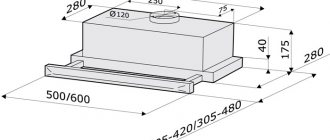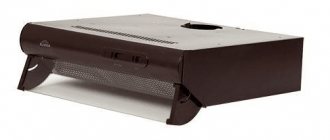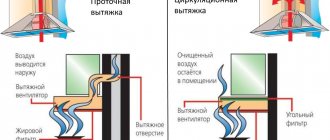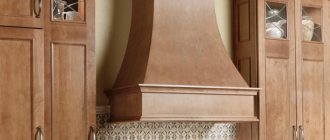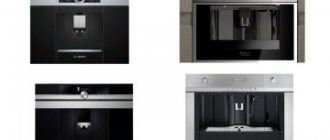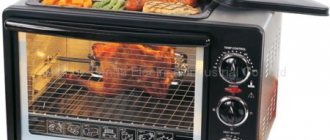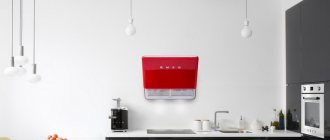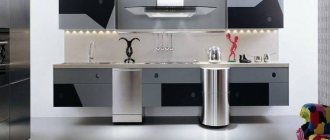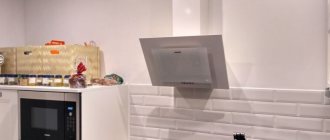The installation of a hood in the kitchen is determined by the standards for arranging ventilation in a residential area. If it is not possible to connect the device to the general house system, a hood is installed without venting to the ventilation (other names - recirculation, coal).
We will talk about the features and principle of operation of an exhaust device without an air duct. The article we have presented describes in detail the technical characteristics and discusses its pros and cons. For those wishing to install exhaust equipment themselves, an installation manual is provided.
Typical ventilation schemes in the kitchen
There are two main schemes for kitchen ventilation: natural and forced. In the first case, ventilation is carried out using holes in the walls and open vents, on the one hand, and general house ventilation ducts on the other.
In the second case, air change is carried out mechanically, using the installation of volatile devices. The third, combined option is considered the most successful, in which a natural supply circuit is simultaneously used, according to which air spontaneously enters the room, and forced exhaust through kitchen hoods.
According to the method of air purification, all hoods can be divided into 2 types - exhaust (intake) and recirculation. The latter are not connected to ventilation ducts through pipes and ducts and operate autonomously
There is a third type - combined devices, which are equipped with double filters and an air duct, and can work either connected to the ventilation shaft or independently.
Natural ventilation has the only advantage: to ensure a comfortable microclimate in the kitchen (as in other rooms) no additional material investments are required.
But it has low efficiency. When cooking on an electric or gas stove, heavy odors quickly spread due to slow air exchange.
Devices for providing forced ventilation are much more productive, but the equipment required to implement the mechanical circuit is dependent on the supply of electricity.
Exhaust hoods and recirculation units do an excellent job of cleaning dirty air and removing unpleasant odors, but they do not cover the area under the ceiling, where fumes and grease particles also enter
Taking into account these features, a combined scheme is used, combining the operation of exhaust devices and a natural ventilation system.
You can get acquainted with typical diagrams and options for ventilation in the kitchen in an article that we recommend reading.
Types of hoods
Kitchens can have two types of ventilation: natural and forced. Each option is characterized by both positive and negative properties.
We will not consider the external design; today there is a huge range of models. It is necessary to dwell only on the fundamental differences between the devices. Forced ventilation also has two types.
Exhaust air without cleaning is supplied to vertical ventilation ducts. A flow hood removes air, the pressure in the kitchen decreases, fresh air enters through cracks in windows and doors or from special vents.
The hood has special filters; air is forced through them and cleaned of grease, smoke, harmful chemical compounds and unpleasant odors. Clean air is again supplied to the room.
Types of hoods without venting
If we compare two types of hoods - with and without ventilation outlets - then the first category has more advantages. The main advantage is higher performance, due to which air exchange occurs much faster.
Sometimes a number of technical issues prevent the installation of an exhaust device with a ventilation duct, and you have to buy a kitchen hood without an outlet and connection to the ventilation, that is, a recirculation one.
Based on the installation method, there are two types of hoods: separately installed and built-in. Built-in ones are good because they take up minimal space, and the cabinet in which the working unit is hidden is used additionally for its intended purpose - for storing kitchen utensils
Modern air purification devices differ in their materials, design, and technical capabilities.
Image gallery
Photo from
What are filter devices made of?
Various colors of hoods
Hoods for kitchen islands
Technical equipment of exhaust devices
The cost of devices directly depends on the technical “filling”, the quality of carbon and grease filter elements, design and level of the manufacturer. But you should choose carefully: sometimes models of popular brands are no different from little-known manufacturers, but cost 2-3 times more.
Operating principle of recirculation models
Unlike a hood with a ventilation outlet, coal models do not “pump” air from the room into the ventilation duct, but circulate it and clean it during the filtration process.
Contaminated air from the working area is drawn into the device, passes first through a grease filter, then through a carbon filter and is discharged outside through holes located in the upper part of the housing
The main working elements of the exhaust system that provide recirculation are the motor and the fan. There are options with 2 motors or with 1 motor, but 2 fans on the sides. They are located inside the housing, above the filters (for dome models) or between them (for built-in varieties).
Performance depends on the power of the engine, which operates on a 220 volt network. This means that before installing the coal model, you need to install a separate socket for connection. Some people mistakenly think that only exhaust hoods require supply ventilation to provide the required volume of fresh air.
In fact, recirculation models also require constant updating of the air flow, since air purification with filters does not make it fresher - it simply removes greasy vapors and the smallest particles of dirt. Therefore, natural ventilation also needs to be done daily.
Purpose of hoods
When choosing a hood, attention is paid to performance. So the equipment must pump an amount of air equal to ten times the volume of the room in one hour of operation. All other options will be considered useless. Because they will not be able to remove all accumulated moisture, and this will lead to damage to walls or equipment. In addition, if a person is cooking indoors, a hood will help quickly get rid of carbon dioxide and food odors.
How effective the hood is can be judged by the grille that is installed above the stove. In one month, a large amount of grease and other contaminants forms there. If the device did not work, then all the dirt would settle on the kitchen appliances and walls. However, cleaning it is not as easy as it might seem. We must not forget that constant cooking in conditions of high humidity will sooner or later lead to premature aging of sofas, ceilings and walls. Therefore, a person will have to renovate and buy new furniture.
All contaminated air must leave the room. To achieve this goal, it is enough to buy a hood. At the same time, models are sold today that can easily remove exhaust gas outside or renew air masses using filtration.
Advantages of models with outlet
This option is the most widely used and is used in almost all apartments. The products are not difficult to control and can be easily used near various gas or electric stoves. There is a special umbrella, which is equipped with a removable grille, where various droplets of fat and dust accumulate. This element is an important detail, as it prevents large particles from entering the common channel. Often only forced ventilation is used; for this purpose, the design provides space for one or more fans.
In order for the product to work flawlessly, good inflow must be ensured. If it is not there, the user may encounter a problem such as tipping over. Therefore, air from the ventilation duct will penetrate into the room, unpleasant odors will begin to appear, and the efficiency of the hood will become zero.
Models without outlet
Such devices are powerful air filters. The structure is installed in the same place as the previous version, but unlike them, the dimensions are larger. Therefore, the product may not be suitable for small kitchens. In addition to the removable grille and cooler, the equipment provides space for:
- Coarse filter settings. The main purpose of the element is to retain moisture, fatty particles, and dust. The product is a small aluminum (and sometimes plastic) grille that is used repeatedly and does not require any replacement;
- The carbon filter is used as the main element to remove microscopic particles; it also absorbs various vapors and unpleasant odors. Unlike the previous filter, the service life of the carbon filter is only one month, after which it must be replaced with a new one. The element cannot be purified; the only thing a person can do is dispose of it.
Circulation hood
In addition to models with and without outlet, some manufacturers produce circulation options. Most of these products fully comply with sanitary standards and can be installed not only at home, but also in public catering areas. But it is important to understand that circulation hoods will cost more, since they only have fans with a powerful electric motor.
Technical characteristics overview
When purchasing a new hood or replacing an old one, you need to find out the features of specific models. Attention should be paid to both the structure and design, and most importantly, to the technical characteristics on which the efficiency of the ventilation equipment depends.
Device performance calculation
In order to correctly navigate the choice of an effective device, you need to know the exact area of the room. Typically, both the performance and the desired size of the kitchen are indicated in the technical data sheet of the product.
For example, Krona Camilla 600 has a capacity of 550 m³/h (in recirculation mode - 385 m³/h), so it is recommended for servicing rooms up to 11 m² (ceiling height 2.5-2.7 m).
If you use a less powerful installation for the same area, it simply will not cope with the task, and a more powerful hood will waste energy in vain
To calculate the performance yourself, you need to multiply the volume of the room by the number of recirculation cycles and take into account the error factor. For the kitchen, the minimum number of recirculation cycles is 12, KP is 1.3. Therefore, to find out the required performance, we consider:
11 x 2.5 x 12 x 1.3 = 429 m³/h
We can conclude that when using the Krona Camilla 600 hood, for sufficient air exchange over an area of 11 m², it is better to use the mode with exhaust ventilation, and use recirculation only as an additional function.
An error factor of 1.3 is usually used when calculating the performance of exhaust hoods; for recirculation models it is slightly higher - 1.7.
Is noise level that important?
The second important parameter that you need to pay attention to is the noise level. If the owners of an apartment or house spend a lot of time in the kitchen, it is advisable to keep it to a minimum. This point is also relevant for those who live in studios where the living room is combined with the kitchen.
Strong and sharp noises have a negative impact on human well-being, therefore increased demands are placed on household appliances equipped with fans and motors
Modern devices operate quite quietly, as they are equipped with special acoustic noise protection. In coal hoods, sounds can be made by a fan, a motor, and air moving inside the structure.
In devices with ventilation outlets, noise often appears due to improperly connected air outlet channels.
If you want the atmosphere in the kitchen to be comfortable during and after cooking, give preference to models with a noise level of 50-55 dB. The quietest devices operate in the range of 35-42 dB
The high cost of the model does not indicate that the hood will work quietly. On the contrary, expensive equipment is more productive than cheap equipment, so it is often devices with a high price tag that create a lot of background sounds - more than 60 dB. Let’s assume that the Neff D55ML66N0 model (36 thousand rubles) has a noise level of 72 dB, and the Elica Hidden HT (51.5 thousand rubles) has a noise level of 62 dB.
Convenient control and adjustment
You have to use the hood every day, so it is advisable to purchase a model with accessible, understandable and convenient controls. All control options can be divided into two large categories: manual and remote.
Manual (or mechanical) has varieties:
- slider (more and more rare);
- push-button (the most common type);
Expensive models are equipped with electronic control devices with touch contact panels for transmitting commands.
Models in the mid-price segment are designed traditionally: on the front panel there is a row of buttons with which you can set the desired mode (diversion or recirculation), change the speed, and turn on the backlight.
Modern programmable hoods have a number of useful additional delayed-action functions. For example, the interval ventilation mode will continue to clean the air even without your presence after certain periods of time.
For models with remote control, almost all adjustments are made from the remote control, but the front panel also has buttons or a touch screen for selecting the operating mode. The more convenient the method of operation, the more expensive the equipment.
Important Features and Options
In addition to the basic technical characteristics, there are a number of properties that can become very useful during operation. But if additional functions are not needed, you can save a lot on the purchase, since electronic filling, various modes, and programming increase the cost several times.
Image gallery
Photo from
Lighting – illumination of the work area
Operating modes – outlet and recirculation
Number of working speeds
Availability of filter contamination indicator
The competition of exhaust hoods in the household appliances market is intense, so manufacturers compete to invent new functions. For example, for some models you can regulate not only the intensity of air suction, but also the degree of illumination of the space, and also adjust the speed change in automatic mode.
Guidelines for choosing a hood without communication with ventilation are presented in the article, the contents of which we advise you to familiarize yourself with.
Price
As already mentioned, in principle, all modern hoods can operate in both modes. Thus, the difference will only be in the presence of air ducts and the number of filters used.
| Models of hoods without duct | Short description | Performance in recirculation mode | Dimensions | Price |
| Jetair Senti SI/F/50 | Wall-mounted, horizontal, flat. Metal and carbon filter included. Mechanical control. | 200 m³/h | 500×470×80 | 1990 |
| Turbo F00480 | Carbon filter | – | – | 490 |
| Krona KELLY 500White 1M | Wall-mounted, horizontal, flat. Fur. Control, 3 speeds + intensive mode. | 250 – 350 m³/h, depending on speed | 500×505×150 | 3090 |
| type KE | Carbon filter | – | – | 600 |
| Shindo Pallada sensor 60 SS/BG 4ETC | wall-mounted, inclined, with perimetric suction. Electronic multi-function control, touch panel | up to 350 m³/h | 857×600×400 | 15500 |
| SCPU.02.06 | Carbon filter | – | – | 400 |
| Faber FLEXA M6 AM/X A60 | Built-in cabinet, electronic-mechanical control, 3 speeds, retractable canopy panel | 310 m³/h | 600×280×180 | 3990 |
| type 6093057 | Carbon filter | – | – | 1190 per set (2 pcs) |
| Siemens LI28031 | Built-in cabinet, electronic-mechanical control, 3 speeds, retractable canopy panel | 200 – 300 m³/h | 598×322×280 | 8200 |
| LZ 34500 | Carbon filter with increased resource | – | – | 2580 |
| Best Lift FPX Inox | built into the countertop, retractable panel, electronic control, 4 speeds. Perimetric suction | up to 1200 m³/h | 580×110×1045 | 89400 |
| type 08999115 | Carbon filter | – | – | 1110 |
Obviously, the range of prices for ductless kitchen hoods is extremely wide. There is an opportunity to choose a completely budget option that is inexpensive to operate. Well, if the desire to achieve exclusivity in kitchen design prevails, then ultra-modern models are on sale, the upper price limit of which does not even need to be discussed.
Read more about extractor hood filters
Devices that operate without venting into the ventilation shaft are called coal devices due to the presence of carbon filters, which purify the air from specific kitchen odors. Most often these are plastic cassettes of various shapes and filled with activated carbon.
Sometimes pieces of synthetic material, also impregnated with activated carbon, are additionally used.
Round charcoal cartridges filled with granules or powder are usually sold and used in pairs. The plastic from which they are made does not change properties when heated and is safe for health.
In addition to the carbon filter, there is an anti-grease filter. For built-in models, it is located on the bottom panel and is a metal grille or mesh.
Of course, the mesh cannot catch odors, but it does an excellent job of removing particles of dissolved fat that rise with the steam. In this regard, it is recommended to wash the anti-grease filter approximately once every 30-40 days with non-abrasive agents.
Unlike the carbon filter, which is placed in the hood body along with the motor and fans, the metal grille is visible and is part of the design of the models.
When purchasing replacement products, please note that original and non-original (universal) filters are available for sale. The second group is suitable for many models and is lower in cost than parts produced by the manufacturer.
Carbon filters, as a rule, last for 3-4 months of active use, but the exact data is indicated in the instructions.
